MANTA CATALOG

Manta rays, Manta birostris, are popular visitors to Flower Garden Banks National Marine Sanctuary. One or more may be spotted on any given visit, at any time of year. But, how much time do they spend there? How many different mantas visit the sanctuary each year? Do they hang around one particular bank more than another?
These are all things we would like to know. But first, we must be able to identify the individual animals. For this purpose we have developed a photo catalog of manta rays seen at Flower Garden Banks National Marine Sanctuary.
Identifying a Manta Ray
Each manta ray possesses a unique set of markings and color patterns on its underbelly, almost like a fingerprint. The whole underside is used to distinguish it as an individual--the color of the cephalic fins, the markings and color of the wings, the markings around the gill slits, and the markings on the belly.
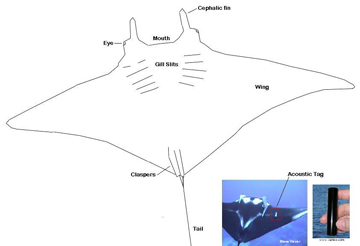
Some mantas have been tagged by researchers, with acoustic tags, which can also serve as a distinguishing feature on their backs.
Sanctuary staff and volunteers have been collecting photos and videos of mantas sighted in the sanctuary over many years. These photos are the basis of a newly developed catalog and poster identifying each of the known individuals.
top of page
Male or Female?
Male manta rays can be distinguished from females by the presence of two claspers that extend beyond the pelvic fins in adult males (see image on left). Females do not have claspers (see image on right).
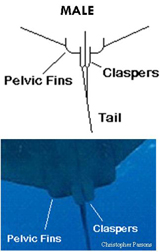
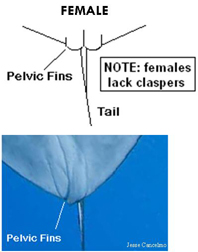
It can be difficult to determine the gender of juvenile manta rays as the claspers, which are male sex organs, are not fully developed until the animal reaches sexual maturity.
top of page
Using the Catalog
The catalog is available for viewing here, by clicking on the category links below.
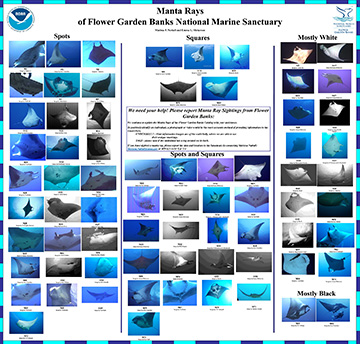
The manta rays in the catalog have been divided into categories to aid in identifying individuals. Each manta ray is placed in a category according to its unique underbelly markings. However, some manta rays' markings can be accurately described by more than one category, so be sure to look at images in all of the categories that may apply.
CLICK ON THE BUTTONS BELOW TO ACCESS
EACH SECTION OF THE MANTA CATALOG
 the individual has spot-like markings
the individual has spot-like markings
 the individual has square-like blotches
the individual has square-like blotches
 the individual has a combination of spots and square markings
the individual has a combination of spots and square markings
 the individual is predominantly black/gray with few other markings
the individual is predominantly black/gray with few other markings
 the individual is predominantly white with few other markings
the individual is predominantly white with few other markings
 the individual possesses a tag on its dorsal (top) side
the individual possesses a tag on its dorsal (top) side
Ongoing Efforts
This catalog is an ongoing project, so new mantas and additional sightings of current mantas are added at every opportunity. If you don't see an image of the manta you observed, it may be a new addition to our catalog.
New and repetitive sightings provide researchers with valuable information about these mysterious creatures, so be sure to report back to us. Please send your mana belly images to flowergarden@noaa.gov along with information on the date and location of the sighting.
We are also interested in any historic manta photos or videos you may have.
top of page
When is a Manta not a Manta?
Manta rays are not the only species of devil ray that frequent the Flower Garden Banks National Marine Sanctuary. Two species of mobulid rays, Mobula tarapacana and Mobula hypostoma, are also seen cruising around the banks.
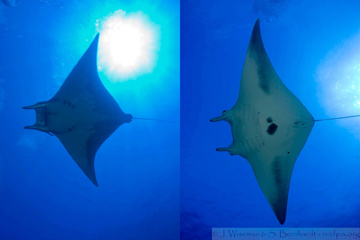
Mobulid ray Manta ray
Both mantas and mobulas have the distinctive cephalic fins in front, but there are ways to tell them apart. One key distinguinshing feature is the location of the mouth. Manta rays have a "terminal" mouth, located at the very front of the head, between the cephalic fins. On the other hand, mobulas have a "sub-terminal" mouth, located on the underside of the head, in a neck-like region. In addition, mobulas are smaller than manta rays and their cephalic fins are much closer together.
top of page
To learn more about the manta research involving acoustic tags, visit our Manta Ray Research web page.
Earlier work on manta rays at Flower Garden Banks National Marine Sanctuary was conducted by Jeffrey N Childs (2001), a graduate student from Texas A&M University.